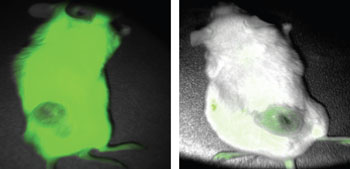Novel Fluorescent Agent Helps Guide Removal of Ovarian Cancer Tumors
By MedImaging International staff writers
Posted on 21 Jun 2016
The results of a trial, published in the June 2016 issue of the journal Clinical Cancer Research indicate that a new tumor-specific fluorescent agent, together with an imaging system, can enable surgeons to remove 29% more malignant lesions than currently possible.Posted on 21 Jun 2016
The researchers first enrolled 30 healthy volunteers to help them determine the optimum dosage and time window for the procedure, and then tested the fluorescent agent in 12 ovarian cancer patients. The researchers also measured tolerability and pharmacokinetics, and whether surgeons could use the procedure.

Image: OTL38 fluorescence imaging of mouse followed by EC17 fluorescence imaging, both with HeLa tumor burden (Photo courtesy of Purdue University).
The new fluorescent agent OTL38, which binds to Folate Receptor-alpha (FRα), was developed by researchers from Purdue University (West Lafayette, IN, USA), and was used for the first time in human subjects by researchers at the Centre for Human Drug Research (Leiden, Netherlands). According to the researchers FRα is expressed in relatively low levels in normal human tissue, but is present in more than 90% of ovarian cancer tissue.
Author of the study, Alexander L. Vahrmeijer MD, PhD, Leiden University Medical Center (LUMC; Leiden Netherlands), said, "Surgery is the most important treatment for ovarian cancer, and surgeons mainly have to rely on their naked eyes to identify tumor tissue, which is not optimal. Near infrared (NIR) fluorescence imaging is a novel technique that may assist the surgeons to improve visualization of tumors during surgery. In our study, using a tumor-specific fluorescent agent and a dedicated imaging system, a fluorescent signal was detected in tumors in real time during a surgical procedure for ovarian cancer called cytoreduction. This allowed resection of additional tumor lesions that were not visible to the surgeons' naked eyes. The main advantage of NIR light is that it can penetrate tissue in the order of centimeters, allowing the surgeon to visualize tumors underneath the tissue surface that can be detected using a dedicated imaging system."
Related Links:
Purdue University
Centre for Human Drug Research
Leiden University Medical Center














